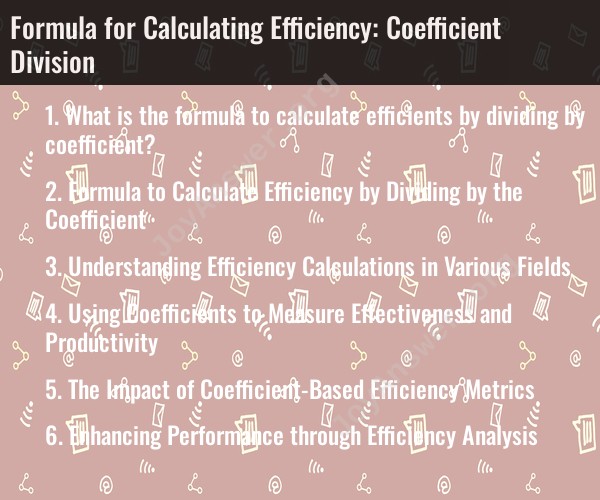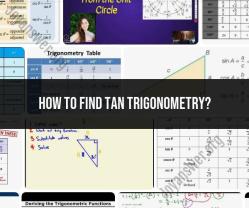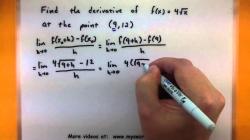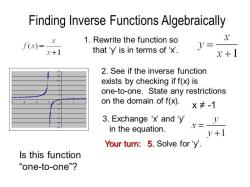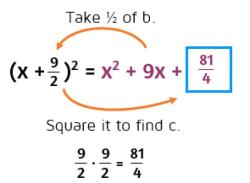What is the formula to calculate efficients by dividing by coefficient?
Efficiency can be calculated by dividing the useful output or work done by the input or energy consumed. The formula for calculating efficiency is:
Efficiency (%) = (Useful Output / Input) x 100
Where:
- Efficiency is expressed as a percentage.
- "Useful Output" refers to the work or output that you want to measure or achieve.
- "Input" represents the energy, effort, or resources that go into a process or system.
The coefficient, in this context, is not typically used in the calculation of efficiency. Instead, the efficiency formula focuses on the ratio of useful output to input. If you have a specific situation in which you believe the coefficient should be included in the calculation, please provide more context, and I can try to assist you further.
Formula to Calculate Efficiency by Dividing by the Coefficient
The general formula for calculating efficiency by dividing by the coefficient is as follows:
Efficiency = (Output / (Coefficient * Input)) * 100%
where:
- Output is the desired outcome or result
- Coefficient is a factor that represents the amount of input required to produce a unit of output
- Input is the resources or effort used to produce the output
Understanding Efficiency Calculations in Various Fields
Efficiency calculations are used in a variety of fields, including engineering, manufacturing, business, and economics. In each of these fields, efficiency is measured in a slightly different way, but the general formula above remains the same.
For example, in engineering, efficiency can be used to measure the performance of a machine or system. For example, the efficiency of a car engine is measured by the ratio of the mechanical power output to the fuel power input.
In manufacturing, efficiency can be used to measure the productivity of a production process. For example, the efficiency of a manufacturing plant can be measured by the ratio of the number of products produced to the number of hours worked.
In business, efficiency can be used to measure the profitability of a company. For example, the efficiency of a retail store can be measured by the ratio of sales to expenses.
In economics, efficiency can be used to measure the allocation of resources in an economy. For example, the economic efficiency of a country can be measured by the ratio of GDP to the total factor productivity.
Using Coefficients to Measure Effectiveness and Productivity
Coefficients are used to measure the effectiveness and productivity of processes and systems. A coefficient is a factor that represents the amount of input required to produce a unit of output.
For example, the coefficient of performance (COP) of a refrigerator is a measure of its efficiency. The COP is calculated by dividing the cooling capacity of the refrigerator by the power input. A higher COP indicates a more efficient refrigerator.
Another example is the coefficient of utilization (CU) of a machine. The CU is calculated by dividing the actual operating time of the machine by the total available time. A higher CU indicates a more productive machine.
The Impact of Coefficient-Based Efficiency Metrics
Coefficient-based efficiency metrics can have a significant impact on the performance of processes and systems. By measuring and improving efficiency, organizations can reduce costs, increase productivity, and improve quality.
For example, a manufacturing plant can use coefficient-based efficiency metrics to identify and eliminate bottlenecks in the production process. This can lead to shorter production times, lower costs, and higher customer satisfaction.
Similarly, a business can use coefficient-based efficiency metrics to identify areas where costs can be reduced without sacrificing quality. This can lead to improved profitability and increased competitiveness.
Enhancing Performance through Efficiency Analysis
Efficiency analysis is the process of measuring and improving the efficiency of processes and systems. It can be used to enhance performance in a variety of ways.
For example, efficiency analysis can be used to:
- Identify areas where waste and inefficiency are occurring
- Develop and implement strategies to improve efficiency
- Track progress over time and make necessary adjustments
By regularly conducting efficiency analysis, organizations can ensure that they are operating at their peak performance.
Here are some tips for enhancing performance through efficiency analysis:
- Focus on the most important areas: Not all processes and systems are created equal. Some are more critical to the overall performance of the organization than others. Focus your efficiency analysis efforts on the most important areas first.
- Use the right tools and techniques: There are a variety of tools and techniques available for conducting efficiency analysis. Choose the ones that are most appropriate for your specific needs.
- Get input from stakeholders: Involve all relevant stakeholders in the efficiency analysis process. This will help to ensure that you have a complete understanding of the situation and that your recommendations are feasible and effective.
- Implement recommendations and track progress: Once you have developed recommendations for improving efficiency, it is important to implement them and track your progress over time. This will help you to identify what is working and what is not, so that you can make necessary adjustments.
By following these tips, you can use efficiency analysis to enhance the performance of your organization and achieve your goals.
